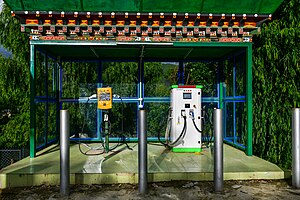Origin and disparities in technological advancements & infrastructure compared to automobile safety sector
Script error: No such module "Draft topics". Script error: No such module "AfC topic".
Over the years, the automobile industry has seen massive technological advancements, including the development of electric and autonomous vehicles. However, when compared to the automobile safety sector, there are still gaps in technological advancements and infrastructure.[1]
History[edit]
The automobile industry has a long history dating back to the late 1800s.[2] Since then, the industry has seen significant technological advances, ranging from the invention of the internal combustion engine to the incorporation of advanced electronics and sensors in modern vehicles.[3] These technological advancements have resulted in the production of safer and more efficient vehicles, but they have also created infrastructure and technological disparities when compared to the automobile safety sector.[1]
Disparities in Technological Advancements[edit]

The automotive industry has been quick to adopt new technologies such as artificial intelligence and machine learning, which have been integrated into self-driving systems.[4] However, disparities in the integration of these technologies into the automotive safety sector persist. Pedestrian detection and automatic emergency braking systems, for example, despite being available for several years, have been slow to be implemented in many vehicles.[5]
Infrastructure Disparities[edit]

In the automobile industry, infrastructure disparities refer to differences in the quality and accessibility of roads and other transportation infrastructure.[6] While the development of electric vehicles has gained traction in recent years, their widespread adoption has been hampered by a lack of charging infrastructure.[7] Similarly, a lack of investment in transportation infrastructure, such as bridges and tunnels, has resulted in dangerous driving conditions, which contribute to accidents and fatalities.[8]
Impact of Disparities[edit]
Disparities in technological advancements and infrastructure in the automobile industry have serious consequences for road safety.[9] For example, the lack of pedestrian detection systems in many vehicles has contributed to a recent increase in pedestrian fatalities.[10] Furthermore, the lack of charging infrastructure for electric vehicles has limited their adoption, resulting in continued reliance on fossil fuels and adding to environmental concerns.[11]
Efforts to Address Disparities[edit]
Several initiatives have been launched to address the disparities in technological advancements and infrastructure in the automobile industry.[12] The National Highway Traffic Safety Administration (NHTSA) has mandated the inclusion of advanced safety technologies in new vehicles, including automatic emergency braking and lane departure warning systems.[13] Additionally, several states have implemented incentives to encourage the development of charging infrastructure for electric vehicles.[14]
Conclusion[edit]
Although the automobile industry has made significant technological advances over the years, there are still gaps in technological advancements and infrastructure when compared to the automobile safety sector.[15] These disparities have significant implications for road safety and the environment.[16] Efforts to address these disparities are ongoing, with initiatives such as the incorporation of advanced safety technologies in new vehicles and the development of electric vehicle charging infrastructure.[17]
References[edit]
- ↑ 1.0 1.1 "Disruptive trends that will transform the auto industry | McKinsey". www.mckinsey.com. Retrieved 2023-03-26.
- ↑ "Who invented the automobile?". Library of Congress, Washington, D.C. 20540 USA. Retrieved 2023-03-26.
- ↑ Marketing, Nisha Sashidharan, Head of (2022-08-17). "The Evolution of Automotive Technology". Extentia Live. Retrieved 2023-03-26.
- ↑ "Artificial Intelligence In Cars: 13 Types of Automotive AI | Built In". builtin.com. Retrieved 2023-03-26.
- ↑ Haus, Samantha H.; Sherony, Rini; Gabler, Hampton C. (2019). "Estimated benefit of automated emergency braking systems for vehicle-pedestrian crashes in the United States". Traffic Injury Prevention. 20 (sup1): S171–S176. doi:10.1080/15389588.2019.1602729. ISSN 1538-957X. PMID 31381447.
- ↑ "Home". www.oecd-ilibrary.org. Retrieved 2023-03-26.
- ↑ "Barriers to Electric Vehicle Adoption: The 4 Key Challenges". www.exro.com. Retrieved 2023-03-26.
- ↑ Heydari, Shahram; Hickford, Adrian; McIlroy, Rich; Turner, Jeff; Bachani, Abdulgafoor M. (January 2019). "Road Safety in Low-Income Countries: State of Knowledge and Future Directions". Sustainability. 11 (22): 6249. doi:10.3390/su11226249. ISSN 2071-1050.
- ↑ Bagloee, Saeed Asadi; Tavana, Madjid; Asadi, Mohsen; Oliver, Tracey (2016-12-01). "Autonomous vehicles: challenges, opportunities, and future implications for transportation policies". Journal of Modern Transportation. 24 (4): 284–303. doi:10.1007/s40534-016-0117-3. ISSN 2196-0577.
- ↑ "Reduction of Pedestrian Accidents – Automated Road Vehicles" (PDF). www.sciencedirect.com. Retrieved 2023-03-26.
- ↑ www.ETAuto.com. "Opinion: It's Critical that EVs be fuelled by renewables - ET Auto". ETAuto.com. Retrieved 2023-03-26.
- ↑ Caporal, Jack; O’Neil, William; Arrieta-Kenna, Sean (2021-04-14). "Bridging the Divide: Autonomous Vehicles and the Automobile Industry".
- ↑ "Automated Vehicles for Safety | NHTSA". www.nhtsa.gov. Retrieved 2023-03-26.
- ↑ "Policies to promote electric vehicle deployment – Global EV Outlook 2021 – Analysis". IEA. Retrieved 2023-03-26.
- ↑ CORPORATION, TOYOTA MOTOR. "Toyota's Discerning Approach to Car-making and Challenges for the Future | Corporate | Global Newsroom". Toyota Motor Corporation Official Global Website. Retrieved 2023-03-26.
- ↑ Bachani, Abdulgafoor M.; Peden, Margie; Gururaj, G.; Norton, Robyn; Hyder, Adnan A. (2017), Mock, Charles N.; Nugent, Rachel; Kobusingye, Olive; Smith, Kirk R., eds., "Road Traffic Injuries", Injury Prevention and Environmental Health (3rd ed.), Washington (DC): The International Bank for Reconstruction and Development / The World Bank, ISBN 978-1-4648-0522-6, PMID 30212112, retrieved 2023-03-26
- ↑ Mastoi, Muhammad Shahid; Zhuang, Shenxian; Munir, Hafiz Mudassir; Haris, Malik; Hassan, Mannan; Usman, Muhammad; Bukhari, Syed Sabir Hussain; Ro, Jong-Suk (2022-11-01). "An in-depth analysis of electric vehicle charging station infrastructure, policy implications, and future trends". Energy Reports. 8: 11504–11529. doi:10.1016/j.egyr.2022.09.011. ISSN 2352-4847.
This article "Origin and disparities in technological advancements & infrastructure compared to automobile safety sector" is from Wikipedia. The list of its authors can be seen in its historical and/or the page Edithistory:Origin and disparities in technological advancements & infrastructure compared to automobile safety sector. Articles copied from Draft Namespace on Wikipedia could be seen on the Draft Namespace of Wikipedia and not main one.
